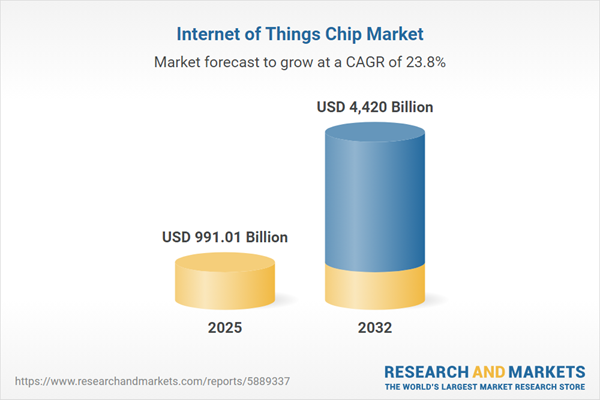Speak directly to the analyst to clarify any post sales queries you may have.
Senior executives face an increasingly complex landscape as the Internet of Things chip market rapidly advances, influencing automation, secure connectivity, and data management at global scale. Adapting to ongoing shifts in technology, regulations, and value chain dynamics is now essential for organizations that seek to future-proof operations and drive impactful outcomes.
Market Snapshot: Internet of Things Chip Market Growth
The Internet of Things chip market achieved a valuation of USD 799.86 billion in 2024 and is forecast to reach USD 991.01 billion by 2025, with a projected market size of USD 4.42 trillion by 2032. This growth is propelled by surging enterprise investment in integrated chip solutions, which form the foundation for digital infrastructure expansion and robust security architecture. Strategic focus on these core technologies fuels automation, resilience, and risk mitigation within complex corporate ecosystems. As the primary keyword for this report, the Internet of Things chip market is seeing heightened executive attention to technology selection and pragmatic deployment of innovations that scale across global operations.
Scope & Segmentation of the Internet of Things Chip Market
This analysis provides a comprehensive breakdown of the sector to guide planning and investment for executive decision-makers:
- Chip Types: Microcontroller units, RF transceivers, sensor chips, and system-on-chip architectures each contribute distinct advantages for streamlining enterprise IoT integration, improving interoperability, and expanding device networks efficiently.
- Connectivity Technologies: Bluetooth, Wi-Fi, Zigbee, 5G, LTE-M, NB-IoT, LoRa, and Sigfox serve a spectrum of deployment scenarios, matching requirements for operational flexibility, coverage, and bandwidth in both centralized and distributed environments.
- Applications: Use cases extend to connected vehicles, telehealth, advanced manufacturing, intelligent building systems, and consumer devices, all of which require specialized chips with built-in security, advanced analytics, and real-time data processing.
- End Users: Organizations in the automotive, energy, utilities, healthcare, manufacturing, and retail sectors leverage IoT chip adoption to improve process automation, visibility, and responsiveness, responding to mounting market and regulatory pressures.
- Deployment Models: Options such as public and private cloud, edge computing, and on-premise infrastructures offer freedom to tailor solutions for privacy, compliance, and cost-efficiency—crucial criteria for adoption and scalability.
- Regional Coverage: The market encompasses the Americas, Europe, Middle East & Africa, and Asia-Pacific, with each region exhibiting unique technology adoption rates, regulatory standards, procurement preferences, and supply chain rhythms.
- Key Companies Analyzed: The report contains detailed insights on major players, including Qualcomm, Intel, MediaTek, NXP Semiconductors, Texas Instruments, Broadcom, STMicroelectronics, Infineon Technologies, Renesas Electronics, and Microchip Technology, supporting robust supplier assessments.
Key Takeaways: Strategic Insights for Senior Leaders
- Embedding artificial intelligence into microcontrollers offers real-time analytics at the edge, allowing operators to derive value from distributed data streams while optimizing infrastructure investments.
- Adoption of current wireless networking standards upholds seamless device connectivity, essential for maintaining workflow continuity across geographically dispersed operations.
- Hardware-level cryptographic security aids organizations operating under strict regulatory conditions by protecting sensitive data and strengthening overall compliance posture.
- Collaborative engagement with technology providers and industry stakeholders accelerates solution deployment, ensuring organizational goals remain aligned with changing market demands.
- Resilient supply chain models, built to span multiple regions, reduce the risks posed by geopolitical uncertainty, supply disruptions, or regulatory shifts.
- Staying abreast of varying global and local regulatory patterns assists with efficient market entry, expansion, and ongoing compliance management in complex jurisdictions.
Tariff Impact on Global Supply Chains
Adjustments in United States tariffs in 2025 have prompted IoT chip manufacturers to recalibrate sourcing and production strategies to address evolving regional needs. Such shifts aim to minimize supply chain exposure while stabilizing core business operations. Executive teams should regularly review procurement and risk frameworks, ensuring adaptability in response to fluctuating international trade policies.
Methodology & Data Sources
The findings presented are based on in-depth interviews with market experts, thorough analysis of company filings, and curated reviews of established industry databases. All data is rigorously validated to support tactical procurement and investment decisions within the Internet of Things chip sector.
Why This Report Matters
- Supports leaders in making forward-focused technology investments and proactively managing structural risks in volatile environments.
- Facilitates precise supplier benchmarking and compliance tracking, enabling streamlined strategy implementation across varied markets.
- Delivers actionable segmentation and region-specific perspectives, guiding organizations in technology deployment and risk planning as market needs grow more complex.
Conclusion
Leveraging cutting-edge IoT chip advancements and adaptive sourcing enables organizations to scale fluidly and respond to evolving industry conditions. Equipped with these insights, senior executives are positioned to drive decisive, strategic growth in an ever-changing market landscape.
Additional Product Information:
- Purchase of this report includes 1 year online access with quarterly updates.
- This report can be updated on request. Please contact our Customer Experience team using the Ask a Question widget on our website.
Table of Contents
3. Executive Summary
4. Market Overview
7. Cumulative Impact of Artificial Intelligence 2025
Companies Mentioned
The companies profiled in this Internet of Things Chip market report include:- Qualcomm Incorporated
- Intel Corporation
- MediaTek Inc.
- NXP Semiconductors N.V.
- Texas Instruments Incorporated
- Broadcom Inc.
- STMicroelectronics N.V.
- Infineon Technologies AG
- Renesas Electronics Corporation
- Microchip Technology Incorporated
Table Information
| Report Attribute | Details |
|---|---|
| No. of Pages | 182 |
| Published | October 2025 |
| Forecast Period | 2025 - 2032 |
| Estimated Market Value ( USD | $ 991.01 Billion |
| Forecasted Market Value ( USD | $ 4420 Billion |
| Compound Annual Growth Rate | 23.8% |
| Regions Covered | Global |
| No. of Companies Mentioned | 11 |









